
The African Wild Dog - once found throughout many African countries, now limited to fragmented populations with few strongholds left and numbers thought to be somewhere between 3000 and 5000 in the wild.
They may be Africa’s most successful large predator, but they are also one of its most threatened species, making any sighting of one of this vanishing predator of Africa a very special treat when on an African safari holiday.
With district colourations, their dappled coat mixed with irregular patterns of reddish-browns, black, white and tan make them easily distinguishable… in fact, their scientific name Lycaon pictus literally translated as ‘painted wolf’. Every wild dog’s coat is unique with colours and patterns varying immensely, making it fairly easy to recognise individuals.

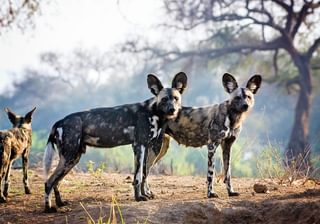
Best time to see
Due to the nature of having huge home ranges, seeing wild dogs can be a little tricky, depending where you go. However, they usually den between March and June with pups being stashed away in den sites. Once the pups are a few months old, packs will often move them from site to site – so between March and October are probably the best times to see wild dogs as they won’t have the ability to move very far with a number of small pups in tow.
Where to see wild dogs
Territory sizes for these critically endangered canines can be vast, so choosing the right place to go to see them is important (as well as the right time of year). Watching wild dogs is always interesting – they have complex social interactions especially when they wake, greeting each other and are often very playful – you’ll be amazed at the similarities you’ll see between wild dogs and your loving companion back home.
Below are some of the best places to see wild dogs - there are other regions where populations exist, but my recommendations stand you the best chance of seeing these marvellous predators.
Zimbabwe
1. Mana Pools National Park
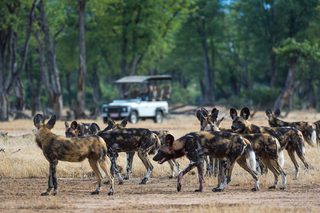
Mana Pools was the setting for the Wild Dogs episode of David Attenborough’s ‘Dynasties’ wildlife series. It’s also renowned for providing exquisite lighting, backdrops providing unique photographic opportunities. And, it is one of the few places where you can experience wild dogs on foot, under the supervision of an experienced guide.
There are two main areas which are very productive when it comes to finding wild dogs in Mana Pools National Park. Firstly, along and near the water pools and banks of the Zambezi River which flows along the northern most boundary of the park, which form a natural barrier with Zambia and the Lower Zambezi National Park across the water. The best time to see wild dogs is the winter months between July and October as the dogs tend to den close to the waterfront areas.
Secondly is the more remote area known as Chitake Springs – which, during the long, dry winter months is the only source of water for miles around, forcing wildlife to congregate, which in turn attracts predators; packs of wild dogs and prides of lions, who lie in wait to ambush those who come and drink at the spring.
Where to stay – Vundu Camp and Little Vundu Camp
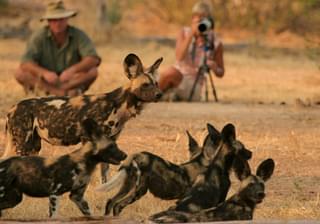
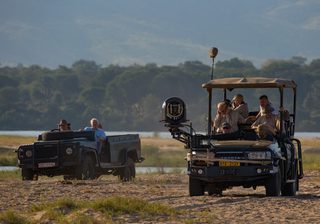
2. Hwange National Park
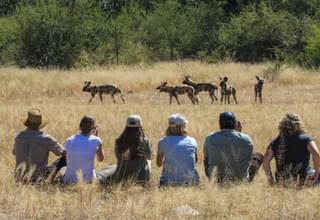
Although Mana Pools may have stolen the lime-light from Hwange, which is Zimbabwe’s largest national park, during BBC’s Dynasties series, it is home to around twice the number of wild dogs with numbers rumoured to be around 200 in over 30 packs. Which is amongst the largest concentration in Africa. The park is home to one of the longest running conservation initiatives – Painted Dog Conservation Project, which is committed to protecting, rehabilitating and reintroducing packs of dogs in to the wild throughout Zimbabwe.
Hwange National Park is roughly the size of Belgium and filled with savanna grasslands and mopane woods making it ideal habitat for wild dogs as well as huge herds of elephants. With no permanent natural waterholes the best time of year to visit are the winter months between July and October when wildlife congregate around available water sources. There are plenty of activities to do in Hwange besides traditional vehicle-based game drives. Walking and horseback safaris give an opportunity to immerse yourself in to the wilderness of Hwange.
A number of the lodges also have viewing hides, usually positioned on the edge of waterholes, providing brilliant opportunities for wildlife viewing and photography.
Trip idea
Classic Zimbabwe with a luxury twist, this trip takes in some of the finest lodges the country has to offer within its game-rich and wonderful scenic National Parks including Hwange, Lake Kariba and Mana Pools.
Duration: 12 Days
Location: Zimbabwe, Africa
Price: £6485pp inc flights
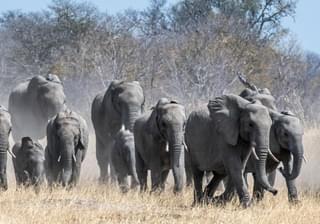
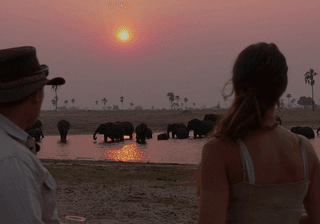
Botswana
3. Okavango Delta
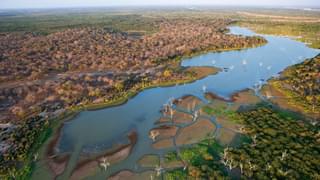
Anywhere in vast open northern Botswana is a good bet for wild dog sightings, with the Okavango Delta being a huge magnet for wildlife. In other words, where there is a decent concentration of game… predators are never far behind. The Delta area and in particular Moremi Game Reserve (located in the Delta) provides a sanctuary for several packs of wild dogs.
The region is vast so generally the prime time to see wild dogs is during the dry winter months between May and June, where water can become scarce, wildlife congregates and wild dogs establish den sites.
4. Kwai Concession
Located on the north-eastern edge of Moremi Game Reserve, this remarkably stunning concession is one of the smallest in Botswana, yet also one of the most scenic.
The landscape of the Khwai Concession is dominated by the Khwai River and operated by the local communities, who take exceptional pride in their local and natural heritage. Beautiful riverine forests line the banks of the river, with regular sightings of lion, leopard and of course wild dogs – making for a wonderfully prolific and world-class safari experience.
Places to stay – The Jackal & Hide
Trip idea
A journey which really highlights the variety of what Botswana has to offer, from the riverine Chobe National Park to the game-rich Khwai Concession and the stark but beautiful Makgadikgadi Pans. No element of this trip is the same as the others which makes for a truly incredible experience.
Duration: 11 Days
Location: Botswana, Africa
Price: £6335pp
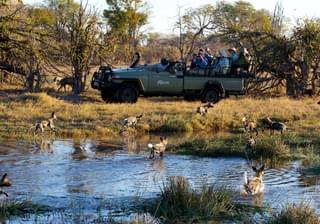
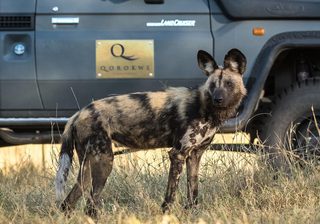
South Africa
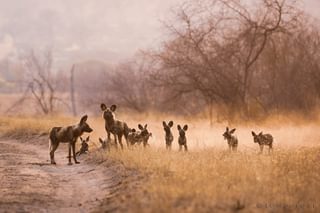
5. Madikwe Game Reserve
The malaria free Madikwe Game Reserve may be small in stature when compared to other areas in our ‘wild dog hotlist'. But despite its modest 750 square kilometre size, safari goers have a very good chance of encountering wild dog here. This fenced reserve underwent a modern-day genesis in the 1990’s where a myriad of wildlife was introduced into what was unproductive farmland, making this a true success story of the rehabilitation of wild areas for conservation purposes.
Where to stay: Madikwe Safari Lodge
6. Kruger National Park & Sabi Sands
Kruger National Park is one of the most well-renowned wildlife areas in Southern Africa and for good reason. It is South Africa’s largest national park and has remarkable diversity with the main park being perfect for exploring on a self-drive safari or staying at one of its private, world-class lodges in the Sabi Sands.
The sheer size of Kruger can make finding the dogs somewhat difficult on a self-drive safari, but from personal experience, I’ll have to admit to being very fortunate with only one trip out of many not resulting in a wild dog sighting. If you're self-driving in Kruger and if you do find dogs asleep under a tree during the heat of the day, the best thing you can do is wait. As the heat begins to subside, that’s when the wild dogs will begin to wake from their daytime slumber and provide you with a fantastic behavioural display.
Sabi Sands – a collection of private safari lodges and areas of land which are still part of the Greater Kruger area but are only accessible to guests staying at the safari lodges which means more intimate, exclusive safari game drives. Even off-roading is permitted for special sightings usually reserved for predators including lions, leopards, cheetah and of course wild dogs.
Where to stay: Londolozi Private Game Reserve
7. Hluhluwe Imfolozi National Park
Located in beautiful Kwa Zulu Natal lies the oldest proclaimed protected reserve area in South Africa, which dates back to 1895 and is the second largest reserve after Kruger National Park. HIP, as it’s affectionately referred to by local South Africans is famous for playing a huge role in ensuring modern day survival of rhino – in fact almost all rhino lineage across Southern Africa can be traced back to this stunning park.
Hluhluwe Imfolozi is a Big Five reserve but seeing wild dogs thriving here is a special treat in itself. With numbers previously decimated, wild dogs were reintroduced to HIP in the early 1980’s and through the valiant efforts of conservation programs, their numbers have grown with multiple packs now being found all over this vastly diverse reserve.
Where to stay: The park itself and the surrounding areas has a great collection of lodges and camps to cater to everyone’s expectations – Speak with our South Africa experts to learn more – Enquire now button/graphic
Trip idea
A trip which embodies the sprit of South Africa to its fullest, offering a chance to explore three of South Africa’s most iconic destinations; Cape Town, the Winelands and Kruger National Park. An exquisite opportunity to sample outstanding food and wine, culture as well as a safari in its most celebrated of National Parks.
Duration: 16 days
Location: South Africa, Africa
Price: £4435pp
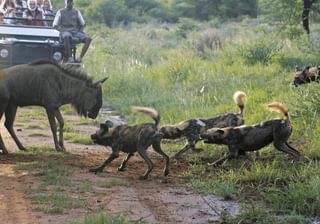
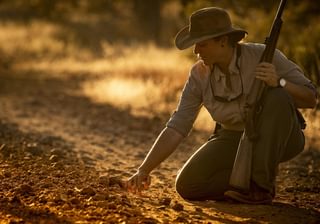
Zambia
8. South Luangwa National Park
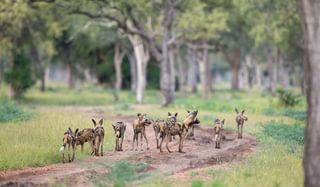
The Luangwa Valley is home to exceptionally rich and varied wildlife populations with concentrations of game around the Luangwa River being one of the highest in Africa. With plenty of hippos, buffaloes, warthogs, the endemic Thornicroft's giraffe, bushbuck, kudu, eland, reedbuck, waterbuck to name just a few.
The area is also well-known for predator sightings; lion, leopard and spotted hyena are seen regularly as well as the illusive Wild Dog. Zambia and South Luangwa might not be the first name on everyone’s safari list but a visit to this stunning area is more than worth consideration as an alternative for those looking for a slightly more adventurous safari.
With an estimated population 350 in the Luangwa Valley, the fortunes of the African wild dog have been given a boost by the Zambian Carnivore Programme’s strategy of de-snaring, land-use planning and vaccinations in local communities to prevent the spread of disease from domestic dogs.
Tanzania
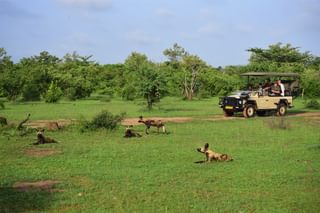
9. Selous
You might be surprised to see that the Serengeti is not the best place to see wild dogs on a safari holiday to Tanzania and there is a lot of research in to the reasons why there are no sizable populations as the eco-system as a whole seems to be perfectly suited. Perhaps it’s the success of lions and hyenas in the Serengeti which has forced wild dogs to seek refuge elsewhere in Tanzania.
Instead, wild dogs can generally be found in the Ngorongoro Crater region, but a better opportunity would be Selous National Park which is home to potentially the largest populations of wild dogs left in Africa – with some 800 roaming the reserves beautiful open grasslands and stunning forest areas. Selous is approximately 50,000 square kilometres in size and although this can make for tough time finding wildlife, it is certainly a far less busy place to visit in comparison to the Serengeti which makes for a more authentic and intimate safari experience.
Where to stay – Selous Serena Camp
Trip idea
We are really excited about this trip, as it provides a glimpse into a lesser known part of Tanzania – The Selous Game Reserve as well as the beautiful Fanjove Island both in southern Tanzania. If you like off-the-beaten-track then this safari takes you to the quieter Selous Game Reserve followed by some beach time on a private island - the perfect bush and beach holiday.
Duration: 12 Days
Location: Tanzania, Africa
Price: £4445pp
Kenya
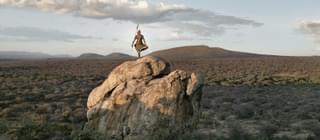
10. Laikipia
Lying at the end of the eastern escarpment of the Great Rift Valley, Laikipia is renowned for its community-run conservancies with several endangered species benefitting from locally run conservation programs including black rhino and reticulated giraffe.
The semi-arid wilderness of Laikipia is probably the only region in Kenya where wild dog sightings occur with a fair amount of regularity, this mainly due to a number of packs which seem to den consistently in this area. But this was not always the case…
During 2017, wild dog populations was decimated with around 10 packs being wiped out by canine distemper. There is good news, they’re making a comeback. Towards the end of 2018, wild dogs were once more spotted in the Loisaba Conservancy – no doubt helped by helped by ambitious vaccination programmes for domestic dogs in the area.
Laikipia boasts some of the highest densities of wildlife in the country, rivalling even the Masai Mara and Tsavo National Park so not only is it a beacon for conservation projects it’s also a fantastic destination for any safari to Kenya.
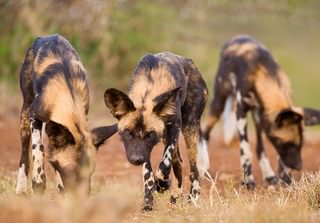
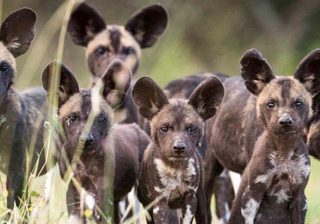
A conservation story
African wild dogs are struggling to cope with the rapid increase and development of human infrastructures which encroach on their traditional range. But there is hope with larger areas of land being set aside for conservation not just for wild dogs but for wildlife as a whole.
They are perfectly adapted to their natural environment and are able to survive and thrive across many different habitats. However, they require vast territories – much larger than most other carnivore species such as lions and leopards. This means that one of the major problems wild dogs face is contact with humans and also their domesticated dogs. Wild dogs are susceptible to most of the same infectious diseases as their domesticated cousins; canine distemper, parvovirus and in particular rabies have been a major factor in population extinctions.
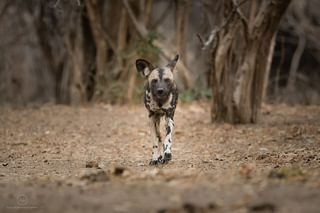
Wild dogs are exceptional hunters and whilst they normally prefer wild prey, they may attack domestic livestock if the opportunity arises, leading to conflict with farmers, which then potentially results with in pack members being shot.
There are numerous conservation efforts throughout Africa which focus on coexistence, conflict resolution, accident and disease prevention. For example, domestic livestock killed by dogs is purchased at a fair price to deter farmers from shooting dogs. Rabies vaccines are also being distributed to local communities to inoculate their domestic dogs in an effort to curb the spread of infection.
Another large factor for the demise of these wonderful predators is through poaching and the laying of snares. The dogs themselves are not the intended target for poachers, they are more interested in catching bushmeat such as antelope, warthogs etc.... As the wild dogs travel quickly through the bush they will become caught in the snares, whether it’s around their neck or legs, causing horrific injuries. In fact, I have seen many a wild dog carrying deep scars or even missing limbs as the result of being inadvertently caught in a snare.
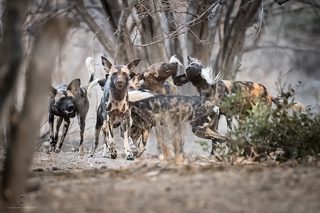
African wild dogs are among the most effective predators in the world. They use extraordinary cooperation and teamwork to pursue, overhaul and bring down their prey. As a result 80% of their hunts end successfully, compared to lions at roughly 20%.
The reason they are so incredibly successful is largely down to pack coordination. Which is still to this day a much-studied research topic. In fact, it was only recently discovered that they use sneezes to ‘vote’ on hunting decisions – just one of many fascinating African wild dogs facts.
Watching wild dogs on the hunt or even just on the move is fascinating - they can cruise through the bush at impressive speeds and can reach up to 70km per hour when in full chase, so keeping up with them even in a vehicle can be tricky and exhilarating. When they do decide to hunt, wild dogs work as a team using impressive co-ordination, speed and stamina, relentlessly chasing down their prey until they catch up or it can run no further.
This cooperation extends to their social structure; they have complex hierarchies in which only the alpha male and female breed, sometimes having up to sixteen pups – imagine all those hungry mouths to feed! The entire pack helps to look after pups, by regurgitating food for the young after successful hunts. The majority of hunting takes place in the morning and afternoon with dogs usually resting under the shade of tree and bushes through the heat of the day.
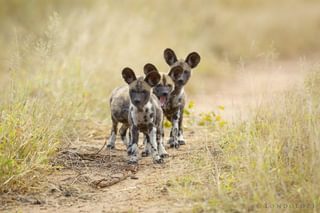
If you do come across a pack of resting wild dogs, it will be well worth the wait or returning to the same area later in the day to watch them wake; each member greets and reaffirms the social bond with others - usually a pack will not set off on their activities until the last one has woken and they're ready to head off a cohesive unit.
Wild dogs, on the whole they are surprisingly non-aggressive with members of their pack; for example they do not fight over food but instead respect the chain of hierarchy and sometimes even allowing younger pack members to feed first.
Looking for some more inspiration? Take a look at our best safari holidays ideas, our favourite family safaris, our big five safari guide or our top African safari honeymoon suggestions.































